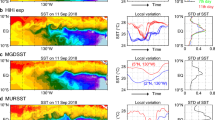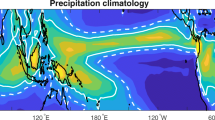Abstract
The inter-tropical convergence zones (ITCZ) form closer to the equator during equinoxes while they form well away from the equator during the boreal summer. A simple three-way balance between the pressure gradients, Coriolis force and effective Rayleigh friction has been classically used to diagnose the location of maximum boundary layer convergence in the near equatorial ITCZ. If such a balance can capture the dynamics of off-equatorial convergence was not known. We used idealized aqua planet simulations with fixed, zonally symmetric sea surface temperature boundary conditions to simulate the near equatorial and off-equatorial ITCZ. As opposed to the convergence of inter-hemispheric flows in the near equatorial convergence, the off-equatorial convergence forms due to the deceleration of cross-equatorial meridional flow. The detailed momentum budget of the off-equatorial convergence zone reveals that the simple balance is not sufficient to capture the relevant dynamics. The deceleration of the meridional flow is strongly modulated by the inertial effects due to the meridional advection of zonal momentum in addition to the terms in the simple balance. The simple balance predicts a spurious near equatorial convergence and a consistent off-equatorial convergence of the meridional flow. The spurious convergence disappears when inertial effects are included in the balance. As cross equatorial meridional flow decelerates to form convergence, the inertial effects cancel the pressure gradient effects near the equator while they add away from the equator. The contribution to the off-equatorial convergence induced by the pressure gradients is significantly larger than the contribution due to the inertial effects and hence pressure gradients appear to be the primary factor in anchoring the strength and location of the off-equatorial convergence.








Similar content being viewed by others
References
Ambaum M H 2008 General relationships between pressure, weight and mass of a hydrostatic fluid; In: Proc. Royal Society of London A: Mathematical, Physical and Engineering Sciences, The Royal Society 464 943–950.
Back L E and Bretherton C S 2009 A simple model of climatological rainfall and vertical motion patterns over the tropical oceans; J. Climate 22(23) 6477–6497.
Bellon G and Srinivasan J 2006 Comments on structures and mechanisms of the northward propagating boreal summer intraseasonal oscillation; J. Climate 19(18) 4738–4743.
Berry G and Reeder M J 2014 Objective identification of the intertropical convergence zone: Climatology and trends from the ERA-Interim; J. Climate 27(5) 1894–1909.
Bony S, Stevens B, Frierson D M, Jakob C, Kageyama M, Pincus R, Shepherd T G, Sherwood S C, Siebesma A P, Sobel A H and others 2015 Clouds, circulation and climate sensitivity; Nature Geosci. 8(4) 261–268.
Chao W C and Chen B 2001 Multiple quasi equilibria of the ITCZ and the origin of monsoon onset. Part II: Rotational ITCZ attractors; J. Atmos. Sci. 58(18) 2820–2831.
Charney J G 1971 Tropical cyclogenesis and the formation of the intertropical convergence zone; Mathematical Problems of Geophysical Fluid Dynamics 13 355–368.
Collins W D, Rasch P J, Boville B A, Hack J J, McCaa J R, Williamson D L, Kiehl J T, Briegleb B, Bitz C, Lin S J and Others 2004 Description of the NCAR community atmosphere model (CAM 3.0). Technical Note TN-464+ STR, National Center for Atmospheric Research, Boulder, CO 00677.
Deser C 1993 Diagnosis of the surface momentum balance over the tropical Pacific ocean; J. Climate 6(1) 64–74.
Dixit V and Srinivasan J 2016 The momentum constraints on the shallow meridional circulation associated with the marine ITCZ; Meteor. Atmos. Phys., pp. 1–15.
Gadgil S 2003 The Indian monsoon and its variability; Ann. Rev. Earth Planet. Sci. 31(1) 429–467.
Gu G, Adler R F and Sobel A H 2005 The eastern Pacific ITCZ during the boreal spring; J. Atmos. Sci. 62(4) 1157–1174.
Hack J J 1994 Parameterization of moist convection in the national center for atmospheric research community climate model (ccm2); J. Geophys. Res.: Atmos. 99(D3) 5551–5568.
Hess P G, Battisti D S and Rasch P J 1993 Maintenance of the intertropical convergence zones and the large-scale tropical circulation on a water-covered earth; J. Atmos. Sci. 50(5) 691–713.
Hu Y, Li D and Liu J 2007 Abrupt seasonal variation of the ITCZ and the Hadley circulation; Geophys. Res. Lett. 34(18).
Krishnamurti T N and Wong V 1979 A planetary boundary-layer model for the Somali Jet; J. Atmos. Sci. 36(10) 1895–1907.
Li T and Wang B 1994 A thermodynamic equilibrium climate model for monthly mean surface winds and precipitation over the tropical Pacific; J. Atmos. Sci. 51(11) 1372–1385.
Lindzen R S and Hou A V 1988 Hadley circulations for zonally averaged heating centered off the equator; J. Atmos. Sci. 45(17) 2416–2427.
Lindzen R S and Nigam S 1987 On the role of sea surface temperature gradients in forcing low-level winds and convergence in the tropic; J. Atmos. Sci. 44(17) 2418–2436.
Mahrt L J and Young J A 1972 Some basic theoretical concepts of boundary layer flow at low latitudes. In: Dynamics of the tropical atmosphere: Notes from the Colloquium, pp. 411–420.
Möbis B and Stevens B 2012 Factors controlling the position of the intertropical convergence zone on an aquaplanet; J. Adv. Model. Earth Sys. 4(4).
Neale R B and Hoskins B J 2000 A standard test for AGCMs including their physical parametrizations: I: The proposal; Atmos. Sci. Lett. 1(2) 101–107.
Numaguti A 1993 Dynamics and energy balance of the Hadley circulation and the tropical precipitation zones: Significance of the distribution of evaporation; J. Atmos. Sci. 50(13) 1874–1887.
Numaguti A and Hayashi Y-Y 1991 Behavior of cumulus activity and the structures of circulations in an “aqua planet” Model. Part I: The structure of the super clusters; J. Meteor. Soc. Japan 69 541–561.
Oueslati B and Bellon G 2013 Convective entrainment and large-scale organization of tropical precipitation: Sensitivity of the CNRM-CM5 hierarchy of models; J. Climate 26(9) 2931–2946.
Richter I, Behera S K, Doi T, Taguchi B, Masumoto Y and Xie S-P 2014 What controls equatorial Atlantic winds in boreal spring; Clim. Dyn. 43(11) 3091–3104.
Schneider T and Bordoni S 2008 Eddy-mediated regime transitions in the seasonal cycle of a Hadley circulation and implications for monsoon dynamics; J. Atmos. Sci. 65(3) 915–934.
Schneider T, Bischoff T and Haug G H September 2014 Migrations and dynamics of the intertropical convergence zone; Nature 513(7516) 45–53.
Sikka D R and Gadgil S 1980 On the maximum cloud zone and the ITCZ over Indian, longitudes during the southwest monsoon; Mon. Wea. Rev. 108(11) 1840–1853.
Sobel A H and Neelin J D 2006 The boundary layer contribution to intertropical convergence zones in the quasi-equilibrium tropical circulation model framework; Theor. Comp. Fluid Dyn. 20(5–6) 323–350.
Stevens B, Duan J, McWilliams J C, Mnnich M and Neelin J D 2002 Entrainment, Rayleigh friction, and boundary layer winds over the tropical Pacific; J. Climate 15(1) 30–44.
Tomas R A and Webster P J 1997 The role of inertial instability in determining the location and strength of near-equatorial convection; Quart. J. Roy. Meteor. Soc. 123(542) 1445–1482.
Vidyunmala V, Nanjundiah R S and Srinivasan J 2007 The effect of variation in sea-surface temperature and its meridional gradient on the equatorial and off-equatorial ITCZ in an aquaplanet general circulation model; Meteorol. Atmos. Phys. 95(3–4) 239–253.
Waliser D 2002 Tropical meteorology: Intertropical convergence zones (itcz); Encyclopedia of Atmospheric Sciences, pp. 2325–2334.
Waliser D E and Somerville R C 1994 Preferred latitudes of the intertropical convergence zone; J. Atmos. Sci. 51(12) 1619–1639.
Williamson D L 2008 Convergence of aqua-planet simulations with increasing resolution in the Community Atmospheric Model; Ver. 3, Tellus A 60(5) 848–862.
Williamson D L, Blackburn M, Nakajima K, Ohfuchi W, Takahashi Y O, Hayashi Y-Y, Nakamura H, Ishiwatari M, Mcgregor J L, Borth H and others 2013 The Aqua-Planet Experiment (APE) response to changed meridional SST profile; J. Meteor. Soc. Japan 91(A) 57–89.
Yang W, Seager R and Cane M A 2013 Zonal momentum balance in the tropical atmospheric circulation during the global monsoon mature months; J. Atmos. Sci. 70(2) 583–599.
Zhang C, Nolan D S, Thorncroft C D and Nguyen H 2008 Shallow meridional circulations in the tropical atmosphere; J. Climate 21(14) 3453–3470.
Zhang G J and McFarlane N A 1995 Sensitivity of climate simulations to the parameterization of cumulus convection in the Canadian Climate Centre general circulation model. Atmos. Ocean 33(3) 407–446.
Acknowledgements
The authors were supported partially by the Divecha Centre for Climate Change, Indian Institute of Science (IISc), Bengaluru. They thank Dr Ashwin Seshadri for helpful discussions. The super-computer facility provided by Centre for Atmospheric and Oceanic Sciences at IISc – ‘Mandhan’ cluster is acknowledged.
Author information
Authors and Affiliations
Corresponding author
Additional information
Corresponding editor: N V Chalapathi Rao
Supplementary materials pertaining to this article are available on the Journal of Earth Science Website (http://www.ias.ac.in/Journals/Journal_of_Earth_System_Science).
Electronic supplementary material
Below is the link to the electronic supplementary material.
Rights and permissions
About this article
Cite this article
Dixit, V., Srinivasan, J. The role of boundary layer momentum advection in the mean location of the ITCZ. J Earth Syst Sci 126, 78 (2017). https://doi.org/10.1007/s12040-017-0856-5
Received:
Revised:
Accepted:
Published:
DOI: https://doi.org/10.1007/s12040-017-0856-5




